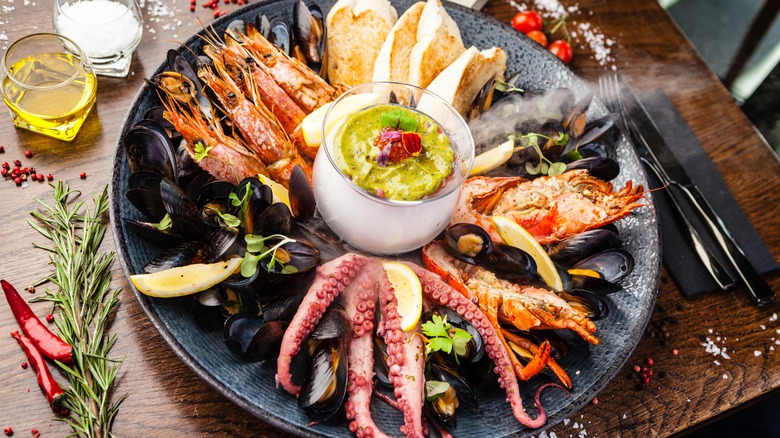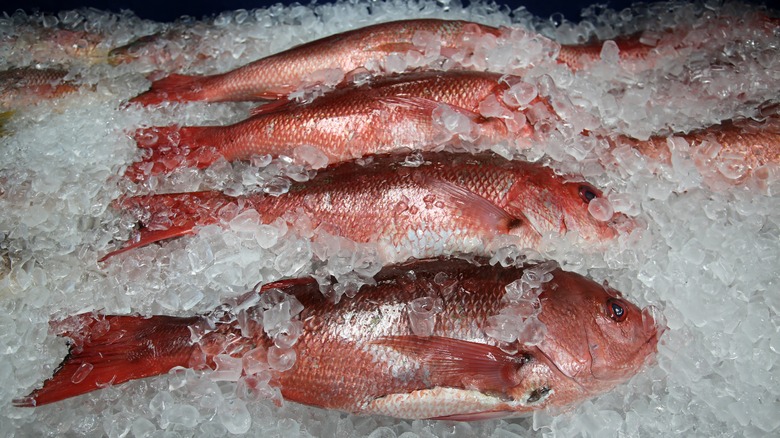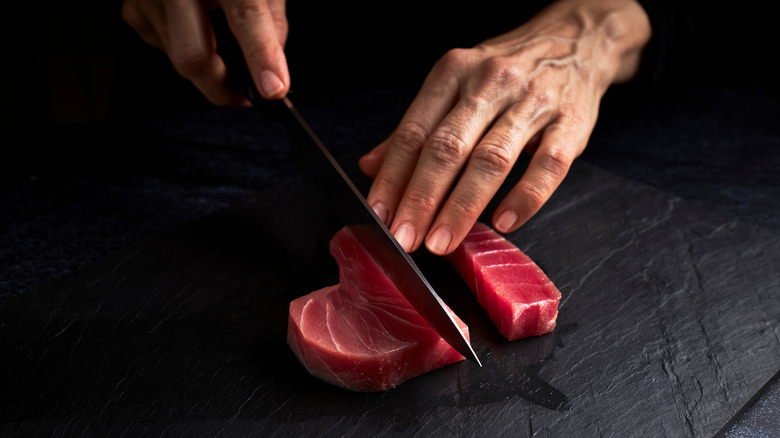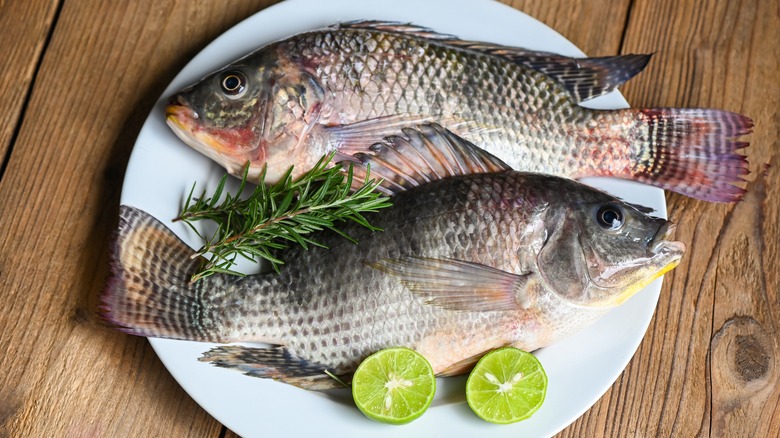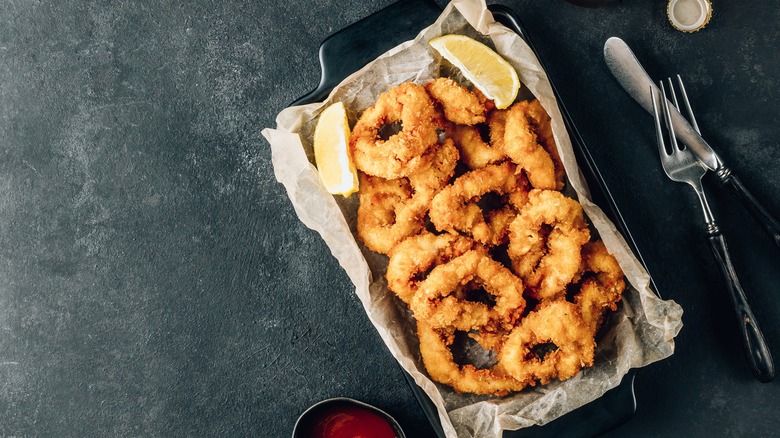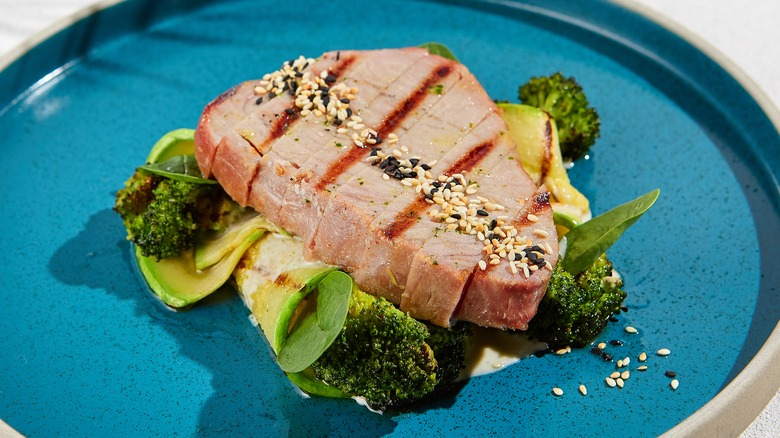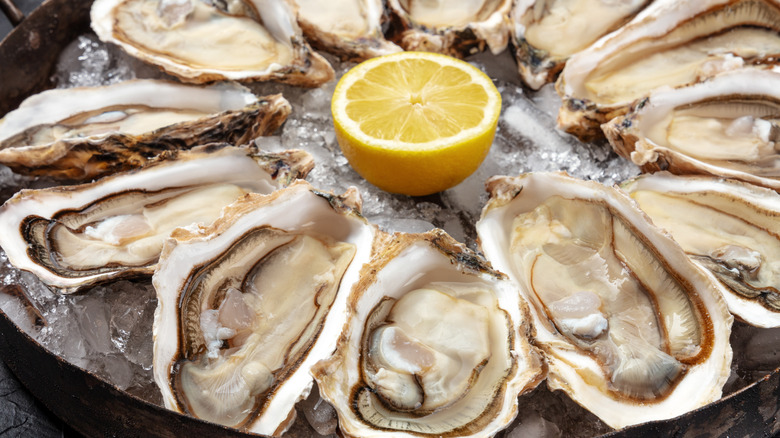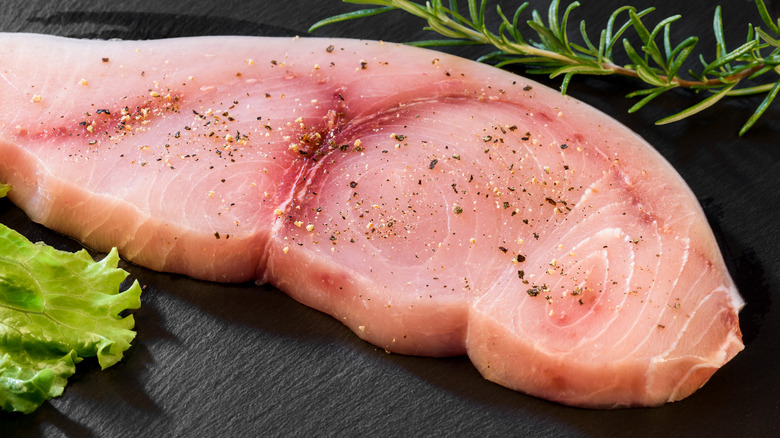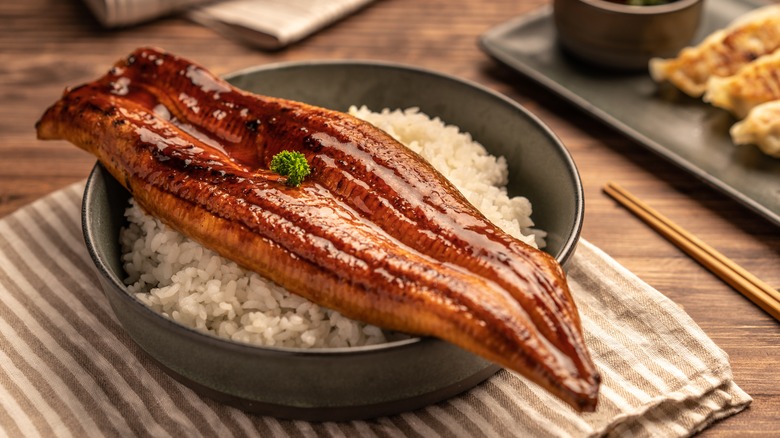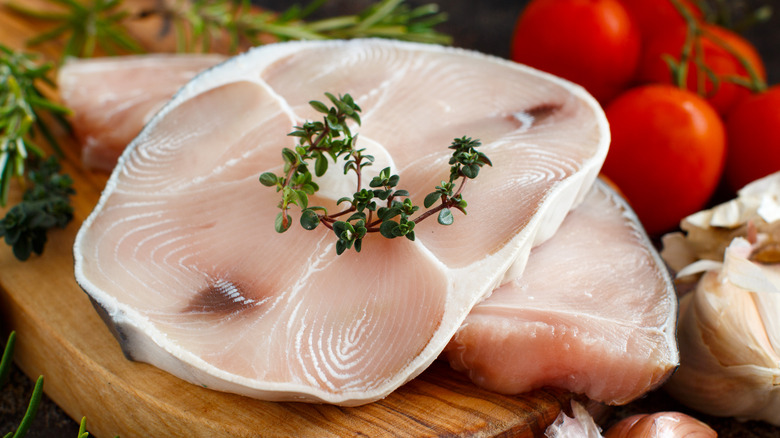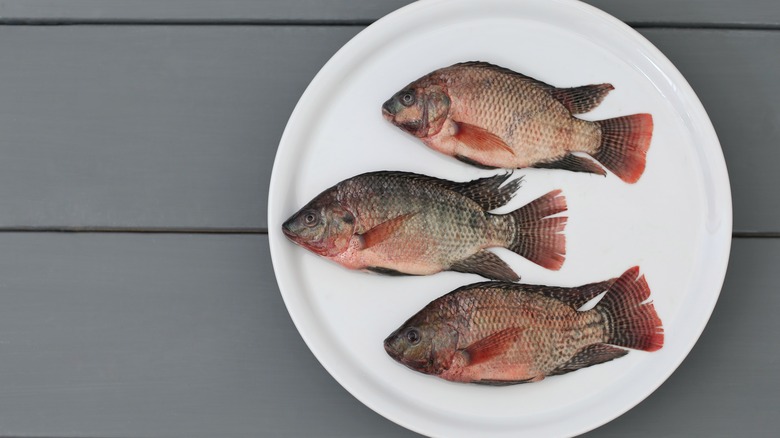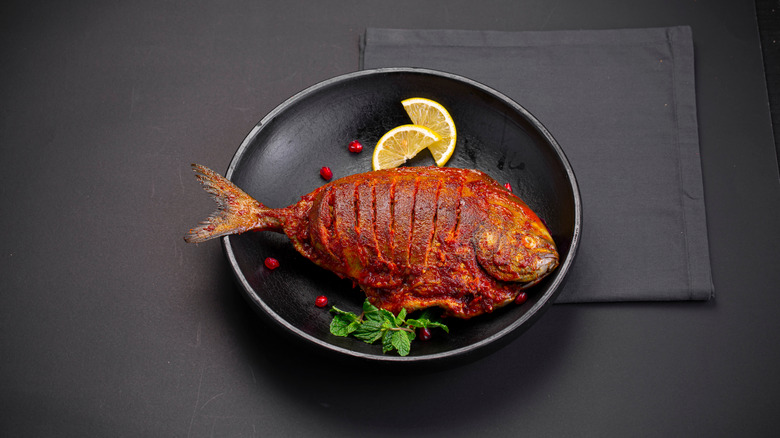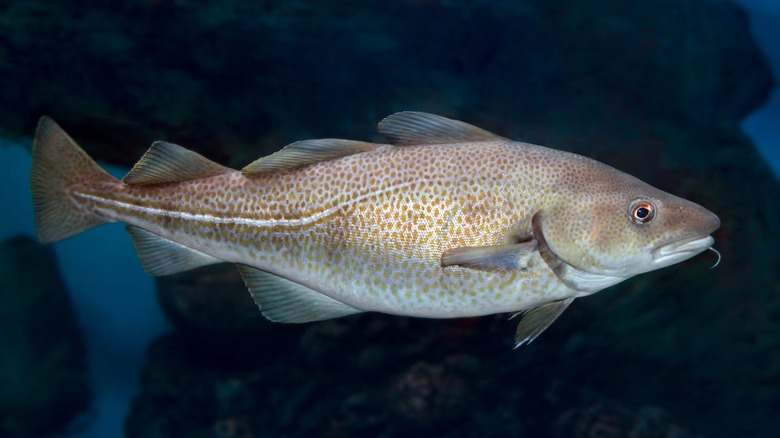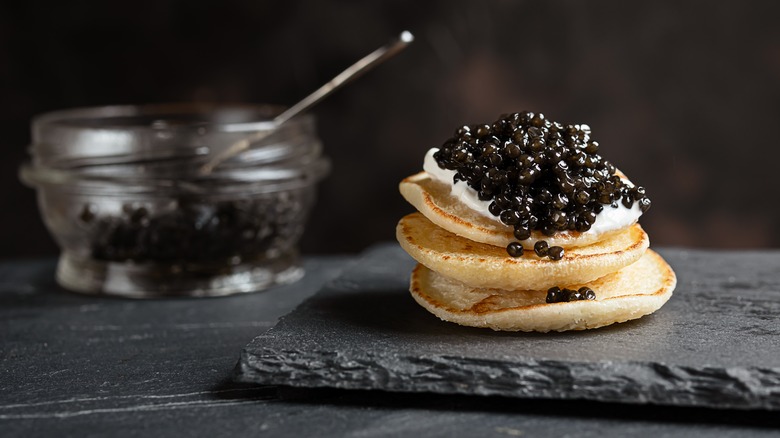14 Dishes You Might Want To Avoid Ordering At A Seafood Restaurant
Seafood is a substantial industry. The worldwide fish and seafood market is almost incomprehensibly enormous, with over $624 billion spent on produce from the world's oceans in 2023, according to Statista. In the United States, you're never far from a seafood restaurant, even if you're inland.
The most popular chain restaurant, Red Lobster, has thousands of locations across the country, while other competing franchises like Bonefish Grill and Captain D's Seafood Kitchen each boasted over 500 restaurants in 2021, as shown in Statista. Seafood offers a taste of the ocean, even when you're miles away from it, and its emphasis on fresh and healthy proteins makes it endlessly popular.
However, consuming seafood can also pose some problems. Seafood can be the source of multiple types of foodborne illnesses, according to the CDC, such as ciguatera and scombroid poisoning, raising questions about its overall healthiness. Additionally, concerns about the sustainability of the fish and seafood being trawled from the sea every year are significant. So, when you're dining in a seafood restaurant, what should you avoid? Luckily, we've figured it out.
1. Red snapper
Red snapper is as visually appealing as it is tasty. This fish, which has a vibrant, almost scarlet coloring, is predominantly found in the Atlantic, specifically in the Gulf of Mexico and has a mild, slightly sweet taste. Its proximity to the United States and its gentle flavor have made it a popular choice in seafood restaurants.
A large-scale study by Oceana examining seafood fraud investigated nearly 700 retail locations across the United States to determine if the fish being sold matched its labels. Shockingly, the study revealed that almost 90% of all fish labeled red snapper were actually something else. Of 120 samples, only seven of them were genuine red snappers.
Seafood fraud poses a significant challenge to combat due to the complexity of supply chains. At any point in the process, fish can be mislabeled as a more expensive option to boost profits. Even experienced seafood chefs might find it difficult to identify the real red snapper when sold in fillet form.
2. Bluefin tuna
Bluefin tuna significantly differs from the stuff you find in the can at your supermarket. This delicacy can yield substantial, meaty tuna steaks and is frequently served as sushi and sashimi, making it an appealing choice for high-end restaurants with sophisticated menus.
But it's worth remembering that choosing bluefin tuna may have an impact on its population. This tuna is classified as endangered by the WWF due to its stocks being overfished and poorly regulated. This is a particular problem for Atlantic bluefin tuna, which face the most risk from unscrupulous fishing practices that don't let the population bounce back quickly enough.
Additionally, it's essential to remember that bluefin tuna, like all types of tuna, may contain higher mercury levels than other fish. Bluefin tuna, in particular, is especially likely to have elevated mercury content as it tends to be bigger and older than other members of the species when it's fished, meaning that the metal has more time to build up in its system.
In certain fish, bluefin tuna may contain up to 1.0 part per million of mercury, almost ten times more than the amount you'd find in canned tuna, making it one of the fish species with the highest concentrations of mercury.
3. Tilapia
Tilapia's rise in popularity appears to be unstoppable, quickly becoming one of the most frequently-farmed fish in the world in just a few decades. As a result, you'll likely find it at many seafood restaurants.
With that popularity came numerous questions about its nutritional value, and you may have heard that tilapia might be bad for your health. A study published in the Journal of the American Dietetic Association argued that tilapia may be particularly likely to cause inflammation and might even have a more significant impact on your health than processed meat.
These claims, however, were later refuted by a host of health professionals. It might be the case that when eaten in moderation, tilapia is actually not that bad for you. So why should it be avoided? Because of the farming practices, it might be subject to. The high demand for tilapia has led to some slightly less-than-savory farming of it around the world, and standards can differ in certain countries.
Tilapia farmed in China, for example, should be avoided, as antibiotics can often make its way into the fish, leading to antibiotic resistance if consumed, according to Seafood Watch. If the restaurant you're eating in can't verify the origin of your tilapia, you're better off ordering something else.
4. Fried calamari
For those who aren't enormous fans of fishier tastes, fried calamari is an excellent choice at a seafood restaurant. The dish is made by taking sliced squid rings, battering them, and deep-frying them, resulting in a crispy finger food with a mild flavor. But while fried calamari might be a safe choice flavor-wise, health-wise, it's another matter due to its cooking process.
When the calamari is deep-fried, it absorbs a significant amount of oil, which can make the dish surprisingly high in saturated fats, trans fats, and cholesterol, depending on the type of fat used. In some cases, the nutritional value of a simple calamari dish can be eyepopping. Red Lobster's fried calamari, for example, contains over 100% of your daily value for fat and 227% of your daily value for cholesterol in a starter that clocks in at 1,000 calories.
This can be the case not only for calamari but for any deep-fried dish you order at a seafood restaurant. Captain D's Butterfly Shrimp, another appetizer, will provide 10 grams of saturated fat, half of your daily value, in just six bite-size pieces. For the healthiest choices at a seafood joint, go for foods that have been grilled or baked, as these will usually be made with less oil.
5. Yellowfin tuna
Like other types of tuna, yellowfin tuna, or ahi, is a popular choice in seafood restaurants thanks to its mild flavor and firm, satisfying flesh. But within that flesh may a few things that you would rather not be consuming. Yellowfin tuna can be a potent vehicle for organic pollutants, which the fish soaks up in its environment and then transfers to humans when they eat them.
A study published in Environmental Health Perspectives sampled 117 different yellowfin tuna samples, many of them caught off the coast of North America. "Every fish [we tested] had some level of pollutants," stated study lead author Sascha Nicklisch via NPR.
Some of the tuna caught off the North American coast were found to be particularly full of pollutants, with certain samples containing 36 times the levels of others. Importantly, though, that didn't mean that all of them were bad, with most of the fish entirely harmless.
Nonetheless, it did show that more work needed to be done. "It's good to know most are safe to eat, but we need to make more information available so people can make their own choices," said Nicklisch. And if you're concerned at all about ingesting pollutants, it may be best to pick another type of fish.
6. Raw oysters
Raw oysters are today considered a delicacy, although it wasn't always this way. The foodstuff's reputation has fluctuated over the years, going from an easy-to-obtain, cheap protein that everyone could eat in ancient times to a high-class option until the middle of the 19th century. From there, it became an easily accessible, affordable food once more, until overfarming caused a price rise, making it exclusive once more.
As such, you may want to avoid ordering raw oysters today because of the price — but there's one other reason, and it's around safety. Oysters feed and grow by absorbing nutrients as seawater passes through their shells. But while they do so, they can also absorb some nasty things. "They're absorbing viruses and pathogens into their meat. It's a process that helps clean the water but doesn't help the consumer of raw shellfish," says food safety attorney Bill Marler, per Insider.
These viruses can survive unless they're cooked at a high enough temperature, raising the risk of illness in the person who's eating them. Infection from vibrio bacteria is especially common when eating raw oysters. Causing a condition known as vibriosis, it can result in symptoms like diarrhea, vomiting, fever, and occasionally serious illness and even death, according to the CDC.
7. Swordfish
Swordfish can make a slightly more interesting choice in a seafood restaurant than your standard salmon or tilapia. But it's also worth remembering the health implications of doing so. Swordfish has an incredibly high amount of mercury in the average serving, with a mean concentration of 0.995 parts per million per portion. For comparison's sake, that's the second-highest amount of mercury of any frequently-consumed fish, second only to tilefish, and way higher than most types of tuna.
While swordfish is generally safe to eat if consumed once in a while, those who order it frequently should be on their guard. Mercury poisoning can produce symptoms as diverse as anxiety and irritability to numbness, muscle weakness, vision problems, and cognitive impairment, according to Healthline.
Swordfish, and other high-mercury fish, are also particularly dangerous if you're pregnant or breastfeeding, as they may impair the nervous system development of the baby, as stated on Healthline. People who are breastfeeding should limit their consumption of swordfish to once per week, and if you're pregnant or trying to conceive, it's best to avoid it entirely. All other adults should also eat no more than one portion weekly to stay on the safe side.
8. Eel
If you're looking for something different in a seafood place, eel could be the way to go. Eel has a subtly sweet flavor and goes especially well with salty-sweet marinades and sauces. The fish has an important place in Japanese food culture and has been on the national menu in the country for thousands of years – but in recent times, the demand for eel has put pressure on supply lines.
This has not only made eel more expensive but has also resulted in serious questions about how eel is obtained for use in restaurants. Eels all over the world are suffering from overfishing, and in certain countries, like Hong Kong, the eel served in restaurants is frequently from an illegal source.
In the United States, the American eel is classified as endangered, with the European eel suffering even more, gaining critically endangered status. Part of the issue is that eels are typically incredibly difficult to breed in captivity, unlike other types of fish which thrive in these settings. By ordering eel anywhere, then, you might be buying into a market that gets the fish via somewhat shady means.
9. Catfish
The humble catfish has, in modern culture, given us two things: A delicious source of protein and a timeless word for a means of deceiving other people. But did you know you might not actually be eating catfish? The fish's name is commonly used to sell other, cheaper types of fish in the hopes that people ordering it in a restaurant won't be able to tell the difference.
A frequent substitute is swai, a white fish with a similar appearance when it's fried to catfish, which restaurants may stock and sell as the latter in order to make more money. "It's unfair. Swai is about two-and-a-half times cheaper than catfish, so there is a larger profit margin if it is marketed under its moniker of 'Asian catfish,' often dropping the 'Asian,'" Houston-based eatery Eadeaux's Cajun Cocina's owner Jason Harry says to Houston Chronicle.
This can result in customers being simultaneously disappointed in the taste of their fish, as swai has a much more gentle taste than catfish and in the cost of their bill. If you're unsure about whether your catfish is actually what it says it is, it's all in the flavor. Catfish is fishy and somewhat muddy, whereas swai has a milder taste and firmer flesh.
10. Shark
Ordering shark in a restaurant has long been considered a somewhat controversial move. Around the world, these fish have long been overfished, thanks in part to the fin trade, both for trophy and for culinary purposes. This has created a huge amount of pressure on shark populations across the globe, as the various species aren't able to give birth and grow to maturity quickly enough to replace the numbers. And as a result, a huge number of species have been driven to extremely low populations and are now endangered or threatened with extinction.
Given the high pressure placed on shark stocks and their vulnerability, combined with the potential for illegal fishing practices around these animals, it's far better to avoid eating them. But if that wasn't enough, there's also the health aspect to consider. Sharks are fish that are especially high in mercury due to their higher-up position on the food chain. As they spend their lives consuming other fish which have smaller concentrations of mercury, their own levels build up — and when humans eat them, they transfer directly into their bloodstream, according to PubMed.
11. Tilefish
The unassuming tilefish is slightly less common on seafood restaurant menus, but you shouldn't take that as a sign to order it if you do see one — there's a good reason why it's rarer. Tilefish populations have faced a huge amount of pressure over the years, and the fish is especially prone to being overfished. The fish has a long lifespan, tending to mature pretty late, and takes longer to reproduce. When demand outstrips supply, the numbers of tilefish then suffer.
There have been good efforts in recent years to protect tilefish, but their population isn't the only reason you shouldn't eat them. Tilefish have by far the highest mercury levels of any fish eaten by humans, with a mean concentration of 1.123 ppm. This is thanks to their particularly long lives, gaining more and more mercury as they get older. If you like the taste of tilefish, you're far better off ordering grouper or flounder: Both of these fish have similar flavors and won't be as high in mercury.
12. The special
Most of us want our meals to be awesome, and ordering the special can seem like a great way to achieve this. But in seafood restaurants, the special can frequently be the thing the chefs are trying to get rid of. "In some restaurants, specials are the way to clean up the fridge," says Aita and LaRina's executive chef Silvia Barban, according to Insider. Specials can typically be thrown together by restaurant owners and chefs to shift stock that's about to be past its prime, meaning you might be paying a premium price for a sub-par product.
In seafood restaurants, in particular, specials may be best avoided on a Monday. The reason for this was explained by the late Anthony Bourdain in his book "Kitchen Confidential: Adventures In The Culinary Underbelly," where he pointed out that as fish restaurants tended to get their stock at the end of the working week, by Monday it's become pretty old. While Bourdain later revised his statement to acknowledge that modern business has changed, and this may no longer be true, he still cautioned against doing so in questionable restaurants where you're not 100% sure of their food standards.
13. Atlantic cod
Cod is enormously popular, and alongside its delicious taste, it carries a lot of significance for certain communities, like those in New England. But Atlantic cod has been put under a lot of pressure in recent years due to a huge amount of overfishing.
This practice, which built in intensity, resulted in the collapse of the Atlantic cod fishery in the early 1990s when the population nosedived so much that the whole industry essentially broke down, leaving thousands unemployed.
This had a massive impact on how people fish in the North Atlantic, with Atlantic cod left to repopulate. But the population is still threatened to this day due to other fishing going on in the area, which can drag up Atlantic cod inadvertently.
These days, if you see Atlantic cod on a menu, ordering it may mean that you're buying into the problem, and it's best to avoid it. If you're craving cod, make sure that the type you're ordering is Pacific, which thrives in much higher numbers, or opt for a different type of whitefish. Pollock and haddock are both fish with a similar texture and taste that won't make the same potential impact when ordering them.
14. Caviar
Few things are considered as classy as caviar. This food has long been a sign of luxury, and its high price on menus is partly down to the length of time its production process takes. But it's also down to the fact that until recently, caviar production was conducted pretty carelessly, with wild sturgeon (which caviar comes from) being fished, extracted, and thrown back into the sea.
While standards have since improved, and sturgeon are now farmed more commonly, that can cause the needless killing of animals just for the roe. And farmed caviar, for some luxury producers, just doesn't stand up to the taste of wild-caught sturgeon. Above all, though, caviar is problematic because its production puts a huge amount of pressure on the ecosystem and requires a huge amount of resources.
"Mackerel, sardines and other foraging fish are landed in Africa or South Asia, and processed for carnivorous fish food. By farming for caviar, you are using food that could feed the many to make a high-value product for the few," says Compassion in Wild Farming's Krzysztof Wojtas, via The Guardian. Whichever way you look at it, ordering this high-price item is likely going to impact things a lot more than you think.
